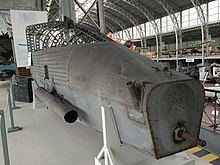LZ 62
| L 30 | |
|---|---|

|
|
| Type: | Zeppelin type r |
| Design country: | |
| Manufacturer: |
Airship construction Zeppelin , Friedrichshafen |
| First flight: |
May 28, 1916 LZ 62 |
| Commissioning: |
June 1916 |
| Production time: |
1916-1917 |
| Number of pieces: |
17th |
The Zeppelin LZ 62 was Count Zeppelin's 69th airship and the 25th airship for the Imperial Navy , where it was designated L 30 .
history
L 30 was the type ship of the "R" class , the so-called super zeppelins with two additional motor gondolas with pusher propellers offset laterally under the middle of the hull. The fuselage was now approximated to a slender teardrop shape, which ensured both lower air resistance and increased gas volume. The new type was 20 meters longer than the previous model and had a considerably larger diameter. The new type had an almost doubled payload with now 32.5 t. The construction of the larger model with significant changes resulted in a longer construction period; In addition, several Zeppelin shipyards were now producing airships, so that construction numbers and identifications not only differed, but also no longer exactly represented the order of completion and takeover. LZ 63 to LZ 69 had already been completed before LZ 62. In addition, the Navy decided to give the first “Superzeppelin” the L 30 identification , although it had only accepted 24 zeppelins by then.
The LZ 62 made its first run on May 28, 1916 and entered service as the L 30 in July 1916. The first in command of the airship was Oberleutnant zur See von Buttlar , who had already commanded L 6 and L 11 . The ship, which was initially stationed in Nordholz , was deployed from Ahlhorn on August 21 . On January 11, 1917 Oberleutnant zur See Friemel became the new commander, who moved to Tondern with the ship in early April 1917 . There, on April 20, 1917, Oberleutnant zur See Boedecker took over command of L 30 , who moved the airship to Seerappen near Königsberg at the beginning of May . The airship stayed there until autumn 1917 together with L 37 and four army airships, which were primarily used for reconnaissance.
L 30 carried out 31 reconnaissance trips and 10 attack trips and dropped 23,305 kg bombs. Only the L 30 and L 31 were able to build on the "successes" of the previous models and together brought around 42 tons of bombs to the enemy. L 31 was shot down burning over London on October 2, 1916 after less than three months of service . After that, the average value per ship fell to around 5 t. Of the six engines, one sat at the end of the driver's gondola, two more in single gondolas in the middle of the fuselage and three in the rear gondola. Here they drove a compressed air screw at the end of the nacelle and two propellers on the sides of the hull via long-distance shafts and bevel gears . With ten machine guns, three of which were on top of the ship's hull, the L 30 and its sister ships had more defensive capabilities and could carry almost five tons of bombs.
These large ships were difficult to handle on the ground and required large support teams. The army did not have sufficiently large halls available, so that only two ships were taken over. Instead, the outdated type “Q” was retained, which was manufactured parallel to the type “r” until the end of 1917.
Sister ships
The type r was the second most built type of the Zeppelin works after the P-class . 17 units of type r were produced. Of these ships, only six saw the end of the war ( L 30 , L 35 , L 37 , L 41 , LZ 113 , LZ 120 ). Three were shot down while burning by fighter pilots ( L 31 on October 2, 1916, L 32 on September 24, 1916, L 34 on November 28, 1916), L 39 by flak . L 47 burned in its hangar and the rest was broken in emergency landings after shelling. The sister ship L 33 ran aground after a joint squadron attack in England, was measured and served as a model for the R34 , which was the first airship to cross the Atlantic.
Whereabouts
L30 was decommissioned on November 17, 1917 in Seerappen and hung in its hall. In 1920 it was delivered to Belgium as reparation dismantled and scrapped. A motor gondola and other parts are exhibited in the Royal Army Museum in Brussels.
Technical specifications
- Carrying gas volume: 55,200 m³ in 19 gas cells
- Length: 198 m
- Largest diameter: 23.9 m
- Drive: six Maybach engines with 240 hp (177 kW)
- Top speed: around 100–105 km / h
- Payload: 32,500 kg
- Bomb load: 3500-5000 kg
- Armament: ten machine guns
- Commissioning: June 1916
See also
literature
- Hans-Jürgen Becker / Rudolf Höfling: 100 years of airships. Motorbuch Verlag, Stuttgart 2000, ISBN 3-613-02071-8
- Horst Freiherr von Buttlar : Zeppelins against England. Amalthea publishing house, Zurich / Leipzig / Vienna 1931
- Ernst A. Lehmann : On air patrol and world travel. Wegweiser-Verlag, Berlin 1936
- Peter Meyer: Airships - The History of the German Zeppelins. Bernard & Graefe Verlag, Bonn 1996, ISBN 3-7637-5951-4
- Hans von Schiller : Zeppelin - pioneer of world air traffic. Kirschbaum-Verlag, Bad Godesberg, 1966
Web links
Individual evidence
- ^ Meyer: Luftschiffe , pp. 46, 52, 65


